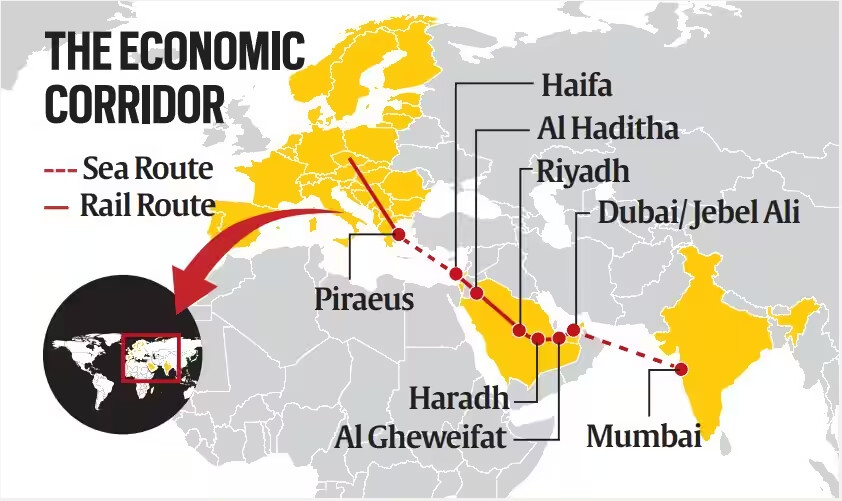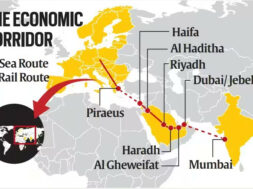
Post-G20 success: Sensex zooms past 67k, Nifty crosses 20k, as manufacturing awaits a Chandrayaan-3 moment
Virendra Pandit
New Delhi; The stupendous success of the G20 Summit was reflected immediately on Monday at the country’s stock markets where Sensex zoomed by 500 points and Nifty50 touched the 20,000 mark for the first time, enthused as India Inc. is with the newly proposed India-Middle East-Europe (IMEE) Economic Corridor for a multinational port and rail link to rival China’s floundering BRI.
While the Sensex crossed the 67,100 mark, the Nifty50 gained for the seventh straight day to cross 20,000, with Reliance being the top contributor. These indicate market confidence and investors’ willingness to troop into India and make it a USD 3 trillion economy by 2030.HighlightsThe Nifty 50 gained
The Rs.110 lakh crore Gati Shakti Infrastructure Scheme, launched in 2021, is now expected to get a major boost to link its emerging projects faster with the IMEE plans, which are expected to go to the drawing board soon.
India’s G20 presidency has presented a golden opportunity to strengthen the country’s collaboration and economy. With the world’s most powerful countries represented, the G20 Summit provided a premier platform for international economic cooperation, accounting for 85 percent of global GDP and 75 percent of global exports.
In the coming years, as the IMEE Economic Corridor progresses, India’s export potential could go up manifold with a corresponding decline in China’s BRI. For one, India has successfully roped in the 55-nation African Union (AU), whose members have rich natural resources and rather untapped markets, and the larger Global South industrial economies’ growth strategies, positioning itself as an attractive manufacturing hub.
In terms of the global economy, the most significant outcome of the G20 Summit, the IMEE Economic Corridor, would be a cost-effective cross-border ship-to-rail transit network that will connect India to the Arab countries, the European Union (EU), and the US. This could translate into huge trade and investment opportunities for Indian businesses.
These emerging opportunities and the slow but decisive shift of manufacturing from China and alternative supply chains could attract many more industries and businesses to India.
With the Indo-US deals taking center stage, other global corporations following suit, and the proposed UK-India post-Brexit Free Trade Agreement are other major factors for boosting the country’s manufacturing sector that could make it the fourth largest in the world by 2030.
Unlike the snail-paced and low-value exports in the past, India’s future economic growth will rely heavily on industries such as automotive, engineering, chemicals, pharmaceuticals, renewable energy, and consumer durables.
Despite its potential, the manufacturing sector could only contribute not more than 17 percent to the country’s GDP in the last four decades. It has also struggled to increase its share of global export of merchandise to 2 percent. India’s share remained below 2 percent since 1948, hovering between 1.5-1.8 percent between 2010 and 2022. China, on the other hand, kept a significant lead over India with a share of 10-15 percent in global export of merchandise since 2010.
China’s advantage in labor-intensive manufacturing at scale, backed by low labor costs and investment in trade-related infrastructure, has enabled it to move towards cutting-edge sectors like robotics and aerospace.
The Dragon’s export-oriented approach focused on industries with higher export potential as it invested in skilling its labor force, allowing for easier technology absorption and movement up the global value chain. In contrast, India struggled to achieve the desired level of skilling, leading to export inefficiency. Its relatively weak infrastructure is a bottleneck for the manufacturing sector, and its surface transportation systems could not meet the expectations of modern high-speed logistics until a few years ago.
The fusion of intelligent digital technologies into manufacturing and industrial processes, known as Industry 4.0, presents an excellent opportunity for a new industrial revolution.
The manufacturing industry is ready for red-hot growth, especially with the Make in India initiative reaching an inflection point. To build a successful ‘Made in India’ brand, the government would continue to build physical infrastructure and promote ease of doing business while also funding Industry 4.0 through start-ups.
Creating and owning designs and intellectual property will be critical, as will investing deeply in Industry 4.0.
India’s G20 success has positioned its manufacturing sector globally. With a government target of USD 500 billion in merchandise (goods) exports for 2023-24, this sector would focus on the untapped export potential in existing tariff lines.














